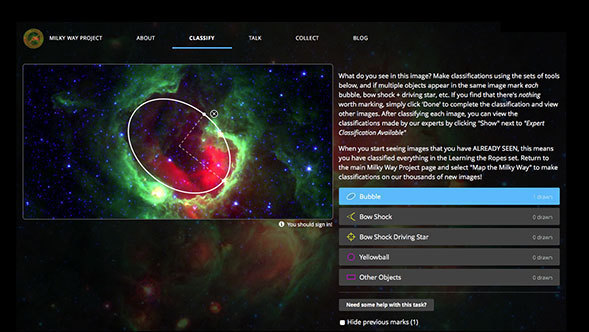
News Release • September 21st, 2016 • feature16-16 •
To most of us, our home galaxy, the Milky Way, seems like mind-boggling, never-ending space. But what does the Milky Way actually look like? How quickly is the Milky Way giving birth to new stars? In their efforts to answer these complex questions, scientists are figuring out new ways to break down the vast amounts of data they collect.
The Milky Way Project, led by Matthew Povich, an astronomer at Cal Poly Pomona, is a website that gathers data for a highly successful citizen science project, funded by the National Science Foundation. Over the last 12 years, NASA’s Spitzer Space Telescope and Wide-field Infrared Survey Explorer missions have captured sweeping new views of our Milky Way galaxy. The website allows anyone to help scientists make sense of this deluge of data.
The Milky Way Project, with over 2 million classification drawings made by 20,000 citizen scientists since 2012, is relaunching its website after upgrading the classification interface.
"We need an additional 2 million classifications to achieve our current science goals," says Povich. "If every one of the 20,000 students at Cal Poly Pomona logged onto our site and made 100 classifications each, we’d be done in no time!"
"The relaunching of the Milky Way Project website will help us acquire a more robust and comprehensive catalog of stellar nurseries and massive runaway stars," adds Cal Poly Pomona physics major Tharindu Jayasinghe, who is analyzing the citizen science data for his senior thesis. "Having everyone joining us in the hunt for amazing astrophysical data makes this project more meaningful."
How does it work? Citizen scientists go to the website http://www.milkywayproject.org. After creating a free Zooniverse user account and following a simple set of instructions, citizen scientists will view infrared images showing different parts of our galaxy and assist professional scientists by making drawings on the images to classify interesting astrophysical phenomena, including interstellar "bubbles" and stellar-wind "bow shocks." These classifications help discover some of the most massive stars in our Milky Way Galaxy.
The Zooniverse is the world’s largest and most popular platform for people-powered research. This research is made possible by volunteers -- hundreds of thousands of people around the world who come together to assist professional researchers. The goal is to enable research that would not be possible, or practical, otherwise. Zooniverse research results in new discoveries, datasets useful to the wider research community, and many publications.
NASA's Jet Propulsion Laboratory manages and operates WISE for NASA's Science Mission Directorate in Washington. The spacecraft was put into hibernation mode in 2011, after it scanned the entire sky twice, thereby completing its main objectives. In September 2013, WISE was reactivated, renamed NEOWISE and assigned a new mission to assist NASA's efforts to identify potentially hazardous near-Earth objects.
For more information on WISE, visit: http://www.nasa.gov/wise
JPL manages the Spitzer Space Telescope mission for NASA's Science Mission Directorate, Washington. Science operations are conducted at the Spitzer Science Center at Caltech in Pasadena, California. Spacecraft operations are based at Lockheed Martin Space Systems Company, Littleton, Colorado. Data are archived at the Infrared Science Archive housed at the Infrared Processing and Analysis Center at Caltech. Caltech manages JPL for NASA.



